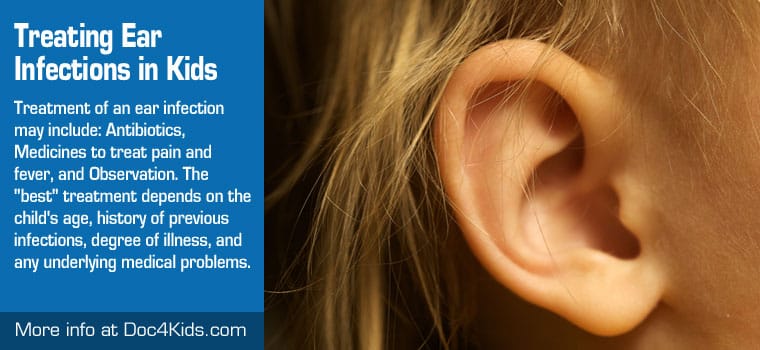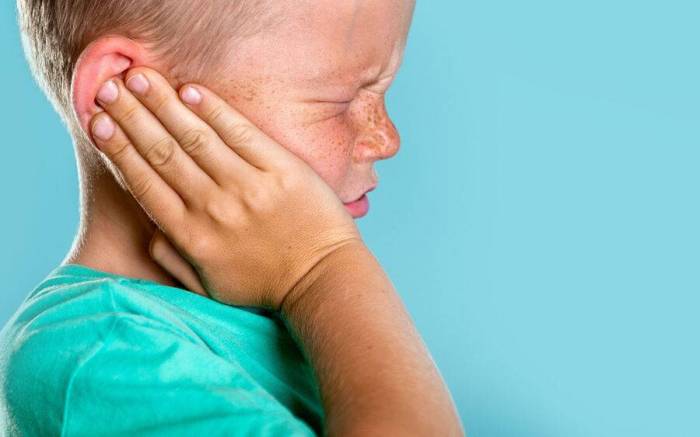
Exploring the realm of identifying and treating ear infections in young children, this introduction sets the stage for a deep dive into a crucial aspect of pediatric health. From common causes to early detection, this topic encompasses vital information for parents and caregivers alike.
As we delve further, we uncover the diagnostic process, treatment options, and preventive measures, shedding light on how to effectively manage ear infections in children.
Overview of Ear Infections in Young Children
Ear infections are a common issue among young children and can be caused by various factors. Understanding the common causes and symptoms is crucial for early detection and proper treatment.
Common Causes of Ear Infections
Ear infections in children are often triggered by bacterial or viral infections that affect the middle ear. These infections can occur as a result of colds, allergies, or sinus infections.
Symptoms to Look Out For
- Ear pain or discomfort
- Fever
- Fluid draining from the ear
- Irritability or fussiness
It is important for parents to be vigilant about these symptoms and seek medical attention if they suspect their child may have an ear infection.
Importance of Early Detection and Treatment
Early detection and treatment of ear infections in children are crucial to prevent complications such as hearing loss or speech delays. Prompt medical intervention can help alleviate symptoms and prevent the infection from worsening.
Diagnosing Ear Infections in Young Children

Diagnosing ear infections in young children is crucial to provide timely treatment and prevent complications. Healthcare providers play a key role in identifying and diagnosing ear infections in children through a series of evaluations and tests.
Evaluation Process
- Health History: Healthcare providers will gather information about the child’s symptoms, medical history, and recent illnesses to assess the likelihood of an ear infection.
- Physical Examination: A thorough examination of the ears, nose, and throat will be conducted to look for signs of inflammation, fluid buildup, or discharge.
Tests and Examinations
- Otoscopy: This involves using a device called an otoscope to examine the ear canal and eardrum for redness, swelling, or fluid accumulation.
- Tympanometry: A test that measures the movement of the eardrum in response to changes in air pressure, helping to detect fluid behind the eardrum.
- Audiometry: In some cases, a hearing test may be done to assess any hearing loss associated with the ear infection.
Treatment Options for Ear Infections in Young Children
Ear infections in young children can be distressing for both the child and parents. It is essential to address the infection promptly to prevent complications and alleviate discomfort. Treatment options for ear infections in young children vary, including the use of antibiotics, home remedies, and alternative treatments.
Use of Antibiotics
Antibiotics are commonly prescribed by healthcare providers to treat bacterial ear infections in young children. These medications work by killing the bacteria causing the infection. It is crucial to follow the prescribed dosage and complete the full course of antibiotics to ensure the infection is completely eradicated.
However, it is essential to note that antibiotics are not effective against viral ear infections.
Home Remedies and Alternative Treatments
In addition to antibiotics, there are several home remedies and alternative treatments that can help alleviate symptoms of ear infections in children. These include:
- Warm Compress: Applying a warm compress to the affected ear can help relieve pain and discomfort.
- Over-the-counter Pain Relievers: Acetaminophen or ibuprofen can help reduce fever and alleviate pain associated with ear infections.
- Ear Drops: Some over-the-counter ear drops can help alleviate pain and reduce inflammation in the ear.
- Garlic Oil: Garlic oil has been used as a natural remedy for ear infections due to its antibacterial properties.
- Breastfeeding: Breastfeeding can help boost the child’s immune system and prevent recurrent ear infections.
It is essential to consult with a healthcare provider before trying any home remedies or alternative treatments to ensure they are safe and appropriate for your child’s condition.
Prevention and Management of Ear Infections in Young Children
Ear infections in young children can be challenging, but there are steps that can be taken to prevent them and manage the discomfort associated with them.
Prevention of Ear Infections
- Ensure your child is up to date on vaccinations to prevent certain infections that can lead to ear issues.
- Avoid exposing your child to secondhand smoke, as it can increase the risk of ear infections.
- Promote good hand hygiene to prevent the spread of germs that can cause infections.
Importance of Proper Hygiene
Proper hygiene practices are crucial in reducing the risk of ear infections in children. Keeping your child clean and teaching them good hygiene habits can go a long way in preventing infections.
Management of Discomfort
- Use over-the-counter pain relievers as recommended by your child’s healthcare provider to help manage ear pain.
- Apply a warm compress to the affected ear to help alleviate discomfort.
- Encourage your child to rest and drink plenty of fluids to aid in their recovery.
Child Health

Regular pediatric check-ups play a crucial role in maintaining the health and well-being of young children. These routine visits allow healthcare providers to monitor growth and development, address any concerns or issues early on, and ensure that children receive appropriate immunizations and screenings.Nutrition is a key factor in promoting overall health and well-being in children.
A balanced diet rich in fruits, vegetables, whole grains, lean proteins, and dairy products provides essential nutrients for growth and development. Encouraging healthy eating habits from a young age can help prevent nutritional deficiencies and reduce the risk of chronic diseases later in life.
Common Childhood Illnesses and Management
Childhood illnesses such as colds, flu, ear infections, and stomach bugs are common and can be effectively managed with proper care and treatment. It is important for parents to monitor symptoms, seek medical advice when needed, and follow healthcare provider recommendations for treatment.
- Common cold: Rest, fluids, and over-the-counter medications can help alleviate symptoms.
- Flu: Antiviral medications may be prescribed for severe cases, along with rest and hydration.
- Ear infections: Antibiotics may be necessary for bacterial infections, and pain management strategies can help relieve discomfort.
- Stomach bugs: Hydration, a bland diet, and rest are key to managing symptoms of gastroenteritis.
Outcome Summary
In conclusion, understanding the nuances of ear infections in young children is paramount for their well-being. By staying informed and proactive, parents can navigate this common health issue with confidence and ensure their child’s optimal health.
FAQ Overview
What are the common causes of ear infections in young children?
Ear infections in children are often caused by bacterial or viral infections, allergies, sinus infections, or exposure to tobacco smoke.
How can parents identify symptoms of ear infections in young children?
Common symptoms include ear pain, tugging at the ear, difficulty sleeping, fever, irritability, and fluid drainage from the ear.
Are antibiotics always necessary for treating ear infections in young children?
Antibiotics are not always required, as some ear infections can resolve on their own. However, in severe cases or persistent infections, antibiotics may be prescribed.
What are some home remedies that can help alleviate symptoms of ear infections in children?
Home remedies like warm compresses, over-the-counter pain relievers, and keeping the child upright can help alleviate pain and discomfort associated with ear infections.
How can ear infections in young children be prevented?
Prevention measures include breastfeeding, avoiding exposure to secondhand smoke, timely vaccinations, and practicing good hygiene to reduce the risk of ear infections.





